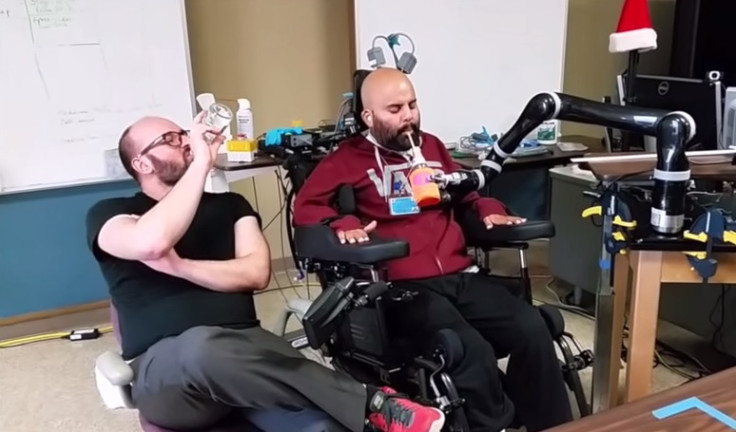Paralysed man drinks beer using bionic arm and chips implanted in his brain

Using two computer chips in his brain and a bionic arm, a man paralysed 13 years ago can now pick up a bottle of beer and drink it unaided.
Shot in the back in 2002, Erik Sorto has been unable to move his arms and legs ever since, but now the father-of-two can control a bionic arm using the power of his brain, interpreted by two chips inside his head. The chips take his thoughts and send them through wires and into the bionic arm on a nearby table.
"That was amazing," Sorto said after using the arm to drink for the first time. "I was waiting for that for 13 years, to drink a beer by myself."
It has taken three years to get to this stage, with Sorto first receiving the chips in 2012. Two weeks after the surgery, he was able to perform a handshake with a researcher. "I was surprised at how easy it was," he said. "I remember just having this out-of-body experience, and I wanted to just run around and high-five everybody."
The neural implants, just four square millimetres in size, are the work of a team of scientists from the California Institute of Technology, who reported their findings in the Science Mag journal on 21 May. Their work is the latest in a series of advancements in prosthetic limbs which they hope will one day lead to restoring smooth, natural and unaided movement to those who have lost limbs through injury or birth defects, and to those like Sorto who have suffered neurological damage.
Sorto said in a statement from the Institute: "I want to be able to drink my own beer - to be able to take a drink at my own pace, when I want to take a sip out of my beer, and to not have to ask somebody to give it to me. I really miss that independence."
Previous attempts to translate brain signals into robotic movements relied on taking messages from the primary motor cortex, an area of the brain responsible for coordinating the contractions our muscles require to move. But this resulted in jerky actions when sent to a robotic limb, so for Sorto researchers instead targeted the the posterior parietal cortex, where movements are planned rather than controlled. Information from here is passed to the arm's computer, which then interprets Sorto's intent and figures out how to pick up the beer.
Researcher Richard Anderson, a neuroscience professor at the Institute, said: "If we can indicate the goal, we can have smooth, natural movements toward the goal."
© Copyright IBTimes 2025. All rights reserved.






















